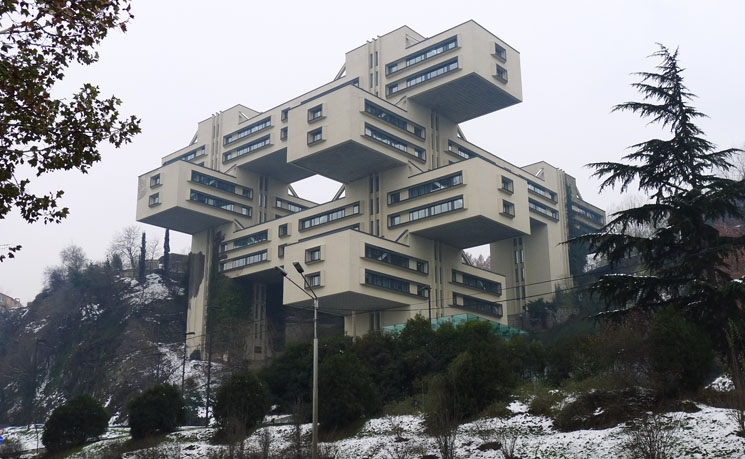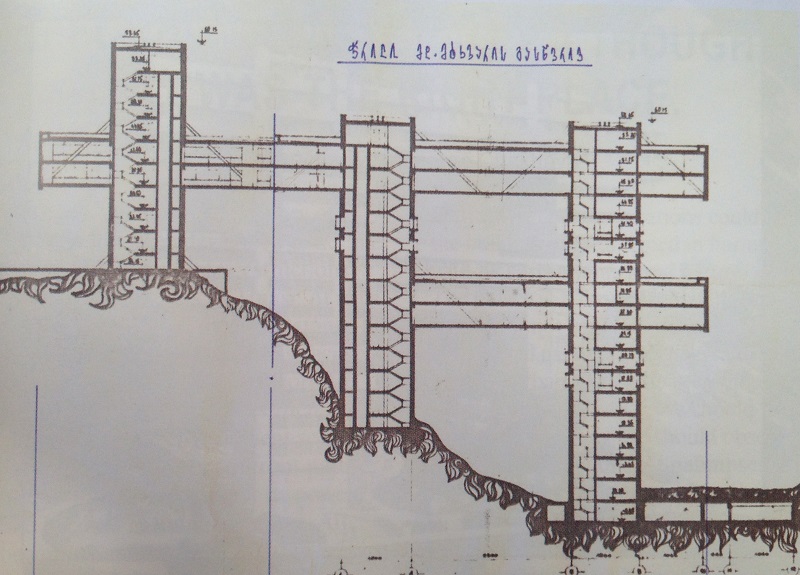Ministry of Transportation Building, Georgia
The former Ministry of Transportation Building in Tbilisi, Georgia, is a striking example of Communist design.
Architects George Chakhava and Zurab Jalaghania designed the building for the Ministry of Highway Construction of the Georgian Soviet Socialist Republic (SSR). Construction was completed in 1975.
The 18-storey building is notable for its unusual design which gives the impression of giant concrete blocks having been piled on top of one another at random. Built on a steep slope, three of the interlocking blocks are oriented on an east-west axis, while two are oriented on a north-south axis. The vertical circulation elements – stairs and lifts – are contained within three cores from which the rest of the structure hangs.
The harsh concrete façade and geometric form was inspired by the theories of the Russian constructivists, as well as the Brutalism movement and the Japanese Metabolists. Following an architectural concept known as the Space City method, parts of the building are raised above the ground, allowing the landscape to grow around and below it.
In 2007, the building was acquired by the Bank of Georgia who converted it into their headquarters, undertaking a major renovation, and installing a new glass cube entrance. In 2007, it was given Immovable Monument status under the National Monuments Act.
[edit] Related articles on Designing Buildings Wiki
- Abandoned movie theatres in Russia.
- Building of the week series.
- CCTV Headquarters.
- Constructivist architecture.
- Fuji TV Building, Tokyo.
- Habitat 67.
- La Grande Arche.
- Manchester Civil Justice Centre.
- Megastructure.
- Metabolism.
- Nakagin Capsule Tower.
- Owen Hatherley - Landscapes of Communism.
- Palace of Culture and Science.
- Robot Building, Bangkok.
- Scottish Parliament Building.
- Spomeniks.
- The Bierpinsel, Berlin.
- Unusual building design of the week.
[edit] External references
Featured articles and news
RTPI leader to become new CIOB Chief Executive Officer
Dr Victoria Hills MRTPI, FICE to take over after Caroline Gumble’s departure.
Social and affordable housing, a long term plan for delivery
The “Delivering a Decade of Renewal for Social and Affordable Housing” strategy sets out future path.
A change to adoptive architecture
Effects of global weather warming on architectural detailing, material choice and human interaction.
The proposed publicly owned and backed subsidiary of Homes England, to facilitate new homes.
How big is the problem and what can we do to mitigate the effects?
Overheating guidance and tools for building designers
A number of cool guides to help with the heat.
The UK's Modern Industrial Strategy: A 10 year plan
Previous consultation criticism, current key elements and general support with some persisting reservations.
Building Safety Regulator reforms
New roles, new staff and a new fast track service pave the way for a single construction regulator.
Architectural Technologist CPDs and Communications
CIAT CPD… and how you can do it!
Cooling centres and cool spaces
Managing extreme heat in cities by directing the public to places for heat stress relief and water sources.
Winter gardens: A brief history and warm variations
Extending the season with glass in different forms and terms.
Restoring Great Yarmouth's Winter Gardens
Transforming one of the least sustainable constructions imaginable.
Construction Skills Mission Board launch sector drive
Newly formed government and industry collaboration set strategy for recruiting an additional 100,000 construction workers a year.
New Architects Code comes into effect in September 2025
ARB Architects Code of Conduct and Practice available with ongoing consultation regarding guidance.
Welsh Skills Body (Medr) launches ambitious plan
The new skills body brings together funding and regulation of tertiary education and research for the devolved nation.
Paul Gandy FCIOB announced as next CIOB President
Former Tilbury Douglas CEO takes helm.
UK Infrastructure: A 10 Year Strategy. In brief with reactions
With the National Infrastructure and Service Transformation Authority (NISTA).
























